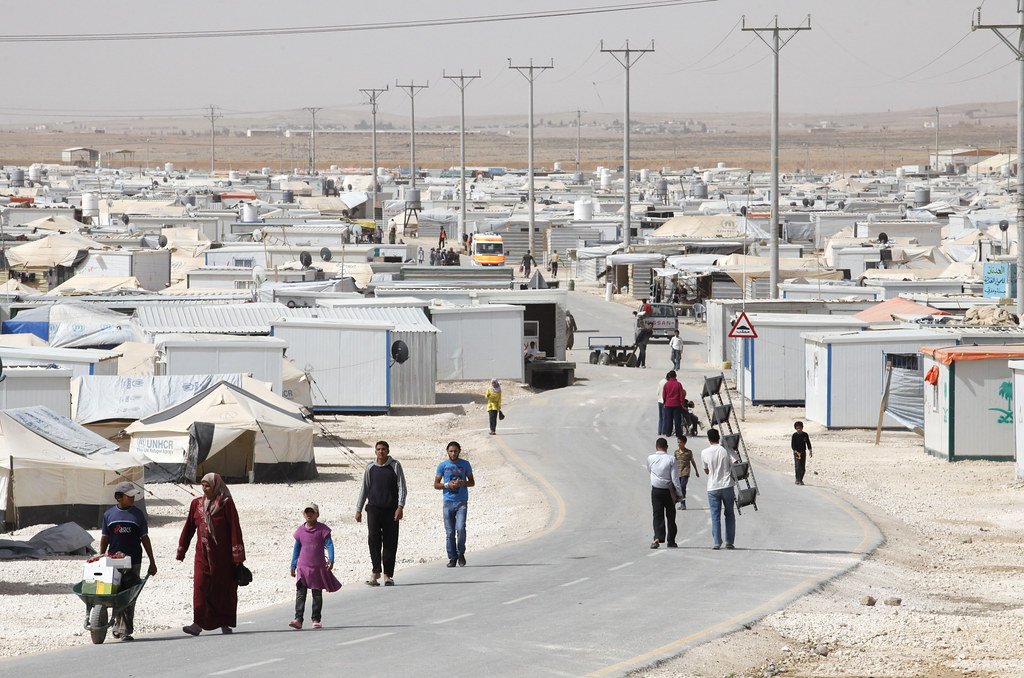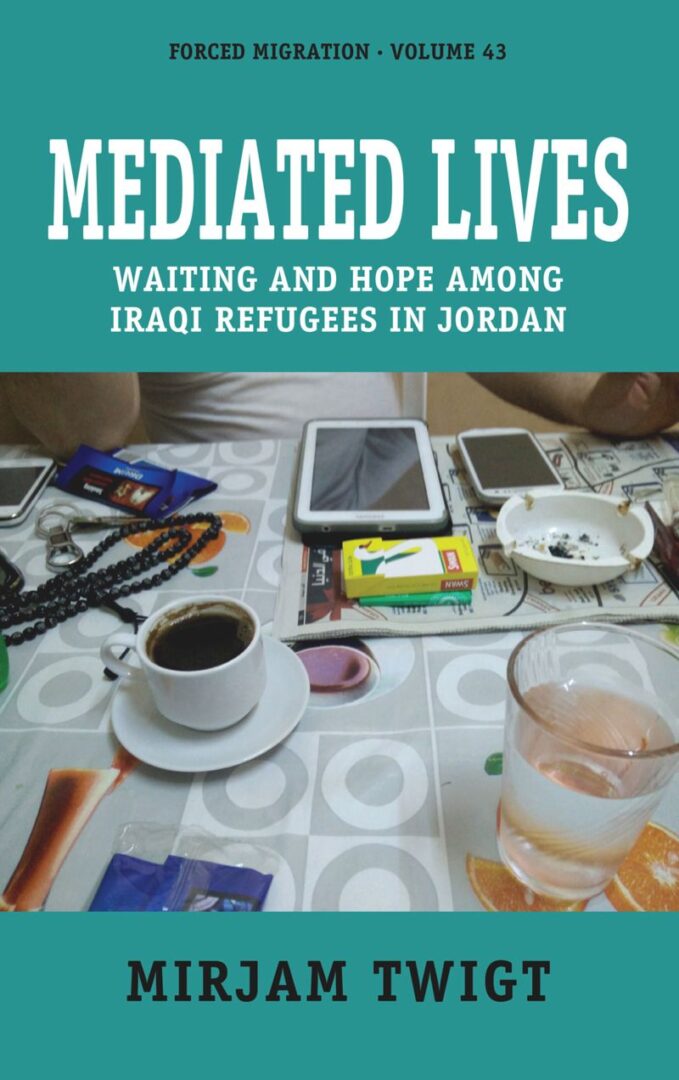

Mediated Lives is a careful, deeply reflexive, and ethnographically rich study of Iraqi urban refugees living through legal, social, and existential uncertainty in Jordan as they await resettlement to a third country. Building upon interdisciplinary literature from media studies, refugee studies, and anthropology, Mirjam Twigt examines “how transnational connections engendered by technological development” contribute to the ways in which ordinary refugees come to “make-sense” of and “make-do” (2) with their refugee predicament, organising their resettlement aspirations under emergent conditions of neoliberal humanitarianism. To achieve this, Twigt argues that scholars ought to trouble the “figure of the connected forced migrant” (4) frequently constructed through narratives of globalisation, and instead approach refugees as being concurrently produced as connected and disconnected through different information and communication technologies.
This latter turn entails an examination of how disconnection – legal, bureaucratic, and material – comes to be a tactic of governance for multiple national and transnational organisations that curtails mobility and security in both the present and the future. Not least among these organisations are the United Nations High Commissioner for Refugees (UNHCR) and International Organization for Migration (IOM), as well as U.S. Immigration Policies and Programs and Jordanian government institutions. For Twigt, these entanglements and how they order Iraqi refugee life in Jordan manifest primarily in the mediation of intersecting scales of waiting through digital technologies and practices: from the bureaucracy of humanitarian organisations to intimate encounters with social media platforms at home.
It is worth noting here that, while Twigt broadly reflects on the implications of her research on knowledge production around urban refugees, readers would benefit from an additional reflection on how these past experiences have shaped her encounters with Iraqi families.
The book is based on ethnographic fieldwork with Iraqi refugee households in Jordan’s capital Amman. We learn that, prior to beginning this research, Twigt had participated in an internship lasting three months at IOM Jordan in 2012, assisting Iraqi refugees on a project funded by the U.S. Bureau of Population, Refugees, and Migration as part of her master’s research, giving her an understanding of the internal logic and operations of humanitarian organisations. After a brief fieldwork trip in 2014, the author returned to Amman for nine months in 2015 to conduct the bulk of the research for this book, working with Iraqi refugees in Amman as they experienced their everyday life while navigating UNHCR bureaucracies and awaiting resettlement. During her time there, the author was invited to live with an Iraqi household in East Amman for three months and suggests that this period provided her with the opportunity to intimately understand how the experience of displacement is mediated in the everyday life of Iraqi refugees in gendered, classed, and racialised ways. At first unable to conduct fieldwork with UNHCR, Twigt was eventually granted permission in 2018 to conduct participant observation in their offices in Amman, including interviews with UNHCR staff. It is worth noting here that, while Twigt broadly reflects on the implications of her research on knowledge production around urban refugees, readers would benefit from an additional reflection on how these past experiences have shaped her encounters with Iraqi families. For example, how did the Iraqi families she worked with perceive her previous work with the IOM? What ethical and practical implications did knowledge of her internship have for their relationship as researcher and interlocutors?
Mediated Lives is organised in seven chapters with an introduction and conclusion that smoothly traverse broadly-reaching scholarly literature. In chapter one, the author sketches the emergence of what has been termed the “Iraqi refugees crisis” (30) and the shifting UNHCR and Jordanian government policies that have come to shape Jordan’s temporary protection space since 2003. There, Twigt contributes critical insight into how these institutions and policies were, and still are, bound to U.S. imperial statecraft in varied ways. For example, Twigt notes how between 2006 and 2019, resettling Iraqi refugees was “reframed as a ‘strategic’ interest for US national security” (42) and thus informed the processing of resettlement applications of Iraqis registered with UNHCR Jordan. In doing so, Twigt also problematises the logic of crisis informing the practices of humanitarian agencies by demonstrating how such logics are entangled with the legacies and practices of imperial statecraft.
This waiting, it bears emphasising, ought not be approached as passive and unproductive.
Amidst the entanglement with these governmental and quasi-governmental institutions, chapter two turns to the different scales of waiting that characterise the uncertainty of Iraqi refugee life in Jordan. There, readers encounter how waiting (dis)orders the everyday life of Iraqi refugees: whereas, at the UNHCR and IOM Jordan’s offices, they wait for their resettlement applications to be processed and to receive the fated call informing them of imminent resettlement, in the intimate sphere of the household, waiting is mediated through Information Communication Technologies (ICTs). While the former is a form of “visible waiting” (53), the latter is much more concealed and shapeshifting, necessitating the kind of grounded ethnographic commitments that Twigt advocates in the introduction to her monograph. This waiting, it bears emphasising, ought not be approached as passive and unproductive. Rather, as Twigt argues, it is characterised by a sense of purpose that extends refugees’ agency over their predicament.
Importantly, and in congruence with Twigt’s emphasis on not ‘disconnecting’, to use her framing, the present experience of forced displacement from past colonial and authoritarian entanglements, she demonstrates how managing those scales of waiting is also informed by past attempts to govern the future under the duality of authoritarian rule and imperial meddling in pre-2003 Iraq. Beginning where chapter two pauses, chapter three focuses on a sit-in protest organised by Iraqi refugees at the UNHCR Jordan’s office. Twigt borrows from Michel de Certeau’s work to demonstrate how these practices come to acquire a tactical quality, allowing those refugees living in conditions of prolonged uncertainty the capacity to render the future imaginable and reachable. Here, Twigt recognises the uneasy terrain of power, emphasising that such tactics may also be dangerous, problematic, and costly for those who deploy them. For example, later on in the book, Twigt shows how fear of the secret informant, arrest, and deportation contribute to the gradual eradication of refugee-led protests. As Twigt (145) notes, while some senior UNHCR staff had attributed the end of protests to their efficiency in responding to the needs of their refugee community, it is also important to recognise that Iraqi refugees experienced genuine fears of deportation and other legal repercussions, informed as they were by the overwhelming suspicion that characterised life in a security state like Jordan – a condition which for a large number of them was exacerbated by its resonance with life under an authoritarian Ba’athist regime.
In chapters four and five, we are introduced to the crux of how digitality comes to order and disorder the different scales of insecurity shaping the lives of Iraqi refugees in Amman. In particular, Twigt examines how experiences of physical, financial, and social insecurity in Amman inform how the resettlement aspirations of Iraqi refugees are negotiated and preserved. For example, deciding whether or not to report acts of physical violence to Jordanian authorities or UNHCR offices may jeopardise resettlement chances. In chapter four, Twigt demonstrates how digitality and virtual spaces mediate the home-making practices of Iraqi refugees as they claim “a sense of place of one’s own, feeling secure and searching for strong social and psychological attachments” (85). Here, home emerges less as a physical or even national space bound by its materiality and territoriality, and more “deeply related to ideas and imaginaries” (85) as well as affective attachments. The mediation of these affective affordances through digital connections is explicitly discussed in chapter five, where Twigt demonstrates how technological connectivity and transnational connections engender and, at times, trouble hopeful attachments to the future, including but not limited to those of resettlement, while simultaneously mediating other affectively charged everyday practices.
Alongside the increased datafication of refugee life by humanitarian and governmental institutions across the globe Twigt elucidates throughout the book, she observes a shift towards “post-humanitarianism” in the management of refugee life.
Chapters six and seven mark a shift in the direction of the book by turning from refugees’ everyday practices to techno-humanitarian governance. Alongside the increased datafication of refugee life by humanitarian and governmental institutions across the globe Twigt elucidates throughout the book, she observes a shift towards “post-humanitarianism” in the management of refugee life. In the context of Jordan, this change can be primarily distinguished by the emergence of biometric technologies and a reliance on a neoliberal logic of tech-innovation. Interestingly, what appears here is how these institutions not only use technology to present a particular ethos of efficiency to the wider public, but also how such technologies emerge as a tool to legitimise their projects of governance. Thus, in chapter seven, we see how this post-humanitarian turn is mobilised by UNHCR Jordan to effect, demonstrate, and proclaim accountability to its refugee public. There, Twigt particularly examines how the communicability of information through different digital technologies and virtual spheres becomes one way by which to effect such accountability in order to legitimise their project of governance.
Mediated Lives contributes importantly to the vast literature on Iraqi refugees, and particularly those in Jordan, by shifting our analytical attention to the work of digital technologies and practices among refugee communities.
Mirjam Twigt’s Mediated Lives establishes its critical rigour on two fronts. First, by refusing to render Iraqi refugees ahistorical subjects and instead considering how past encounters with authoritarian violence in Iraq and regional legacies of imperialism have come to inform scales of everyday waiting, Twigt offers a nuanced analysis of Iraqi migrant temporality and it entanglement with these complex pasts. This approach overemphasises neither the weight of the Ba’athist past nor U.S. imperial statecraft, highlighting instead the dynamic involvement of different agents in the shaping of contemporary Iraqi life. Second, the author’s critical reflections on her own ethnographic practice and positionality in the field, in addition to the forms of knowledge production in which she locates her work, offer critical insights on how to tackle ethical concerns while working alongside refugee communities. Mediated Lives contributes importantly to the vast literature on Iraqi refugees, and particularly those in Jordan, by shifting our analytical attention to the work of digital technologies and practices among refugee communities. Not only do the book’s clear writing and broad theoretical engagement make it extremely useful for undergraduate teaching, but Twigt’s interdisciplinary approach and analytical framing also render it a must-read for those in forced migration and refugee studies, media and technology studies, and anthropology, as well as practitioners in the field of forced displacement.
Featured Image by Dominic Chavez, courtesy of flickr.com






